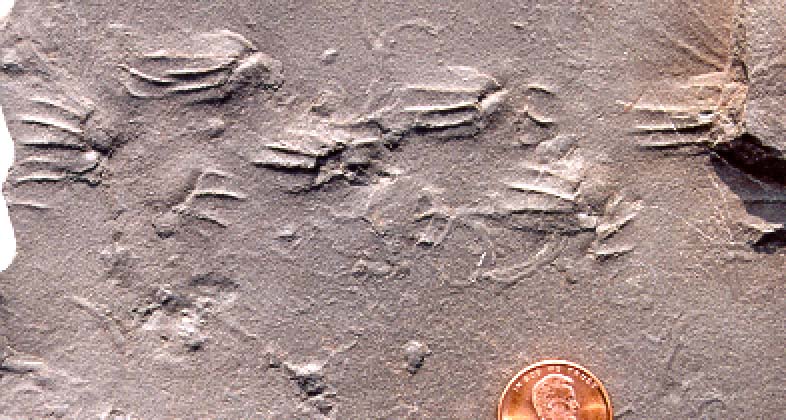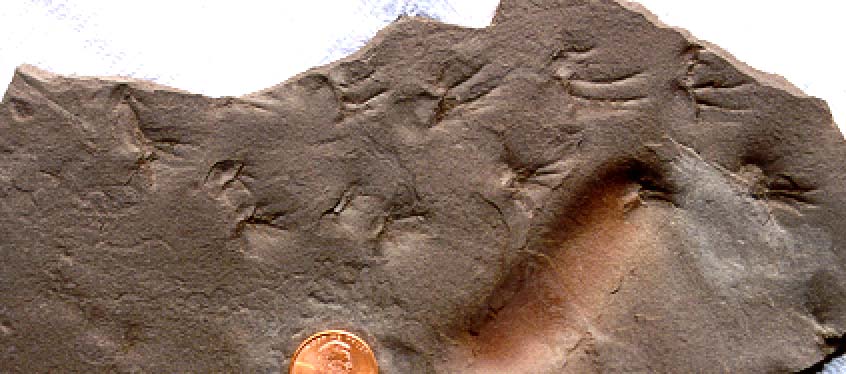This collecting site continues to be popular with the BPS,
today’s field trip being the third organized visit in only four
months. There
were good reasons for returning to the site at this time. First, it is
still
rich in amphibian tracks and plant fossils, in spite of the many people
visiting
the site during the past four months. Second, we were informed by the
owner of the mine that reclamation of the Union Chapel Mine would begin
in late May, and that this may enhance our ability to find new and
interesting
material that had been previously buried in the rock piles. However,
the
reclamation effort has been stalled for a variety of reasons, and I
have heard
that full-scale reclamation might not start until August. Nevertheless,
the
unmoved piles still yield good specimens, and it is still possible to
find good
quality tracks lying exposed in spite of the many visits people have
made to the
mine. Sometimes pieces are missed because of a poor Sun angle or
because people
are tired when they pass an area and simply don’t notice a track
specimen.
I
felt like I had a "good day" today for track and plant fossils
from this site. The first picture shows a fine set of amphibian tracks
with at least four toes. Note how the size of the tracks alternate, as
if the hind and forefeet have different sizes.
|  |
| | Fig. 1 - Small amphibian tracks with at least four toes.
The tracks resemble those of the genus Cincosaurus cobbi in Museum Paper No. 9,
by Aldrich and Jones (1930). However, the tracks here are much smaller than
those illustrated in their article. |
The second picture shows
tracks of a somewhat different creature, again with at least four toes
and possible evidence of a pad.
|  |
| | Fig. 2 - Another set of small tracks with four toes and evidence for a
pad. |
The third and fourth pictures show a
fine set of tracks whose visibility depends on the Sun angle when dry. I
noticed these tracks after splitting a rock. The two halves, giving
direct and inverse impressions, were wet and the tracks obvious.
However, after the pieces dried in the back of my truck, I could not see
the tracks! This set is interesting because it looks like the creature
was walking around an obstacle of some some sort.
|  |
| | Fig. 3 - A small set of tracks where the creature apparently walked
around an obstacle of unknown nature. This set also resembles Cincosaurus cobbi,
but are nuch smaller than the ones illustrated in Aldrich and Jones 1930. |
| | |
| | Fig. 4 - Close up of part of the tracks in the previous picture. |
| The fifth picture shows a definite trace fossil that is likely connected to a
fish. The picture shows two doubled sine waves, and at least one wave has four
peaks on the whole rock. The sine waves could be due to fins scraping the
bottom, and perhaps two fish made these tracks, each with a pair of fins
touching the mud. | 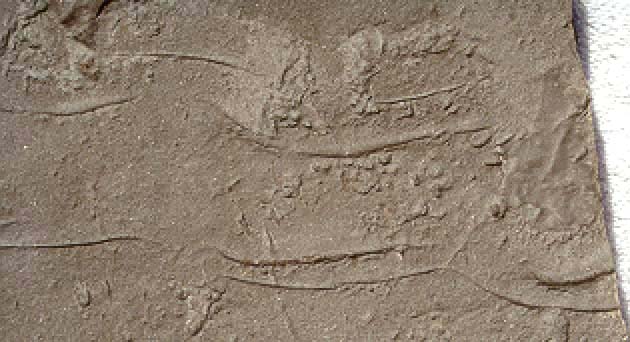 |
| | Fig. 5 - Possible trace fossils of fish fins swishing along bottom of
shallow water or swampy area. |
| The sixth picture shows an interesting trunk cast of a small tree. I had a
hard hat on this visit, and felt emboldened to go a little closer to the high
wall than I had been before. I found this stunning small trunk near but not
exactly at the wall. I call this the "Devil’s Tower" specimen
because it strongly resembles Devil’s Tower in Wyoming. The black verticle
bands represent carbonized plant material, and I suspect the tree was a species
of Sigillaria. Since it tapers a little, I also suspect the piece was near the
bottom of the trunk. |  |
| | Fig. 6 - The "Devil’s Tower" specimen, a trunk cast of
small lycopod, probably of the genus Sigillaria. |
| The seventh picture shows a variety of typical bark impressions and a small
cast of a Calamites pith I found on this day. The bark impressions are of the
genus Lepidophloios, by far the most abundant type at this site. This is in
great contrast to the Warrior construction site (see BPS field trip report for
March 27, 1999), where hundreds of bark impressions of Lepidodendron have been
found, but no definite pieces of Lepidophloios. | 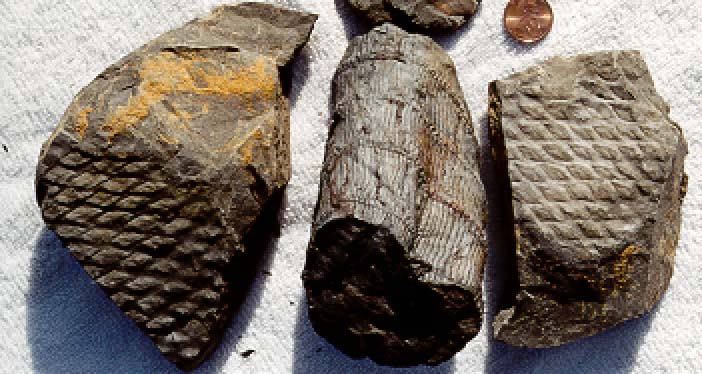 |
| | Fig. 7 - Various bark impressions of Lepidophloios and a Calamites
medullary cast fossil |
| Other Track Impressions | 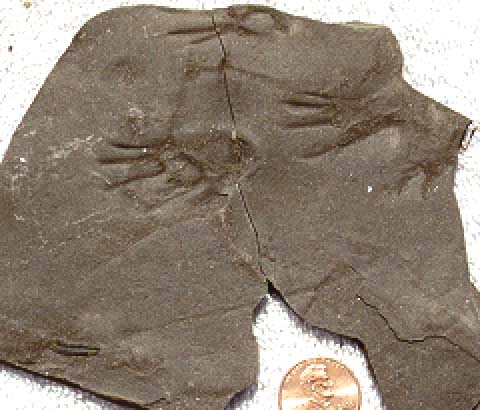 |
| | Fig. 8 - A medium sized set of a few tracks, likely to be Cincosaurus
jonesii (Aldrich and Jones 1930). |
| The final pictures I show are of a few tracks found on different days but
which have not been shown in previous reports. | 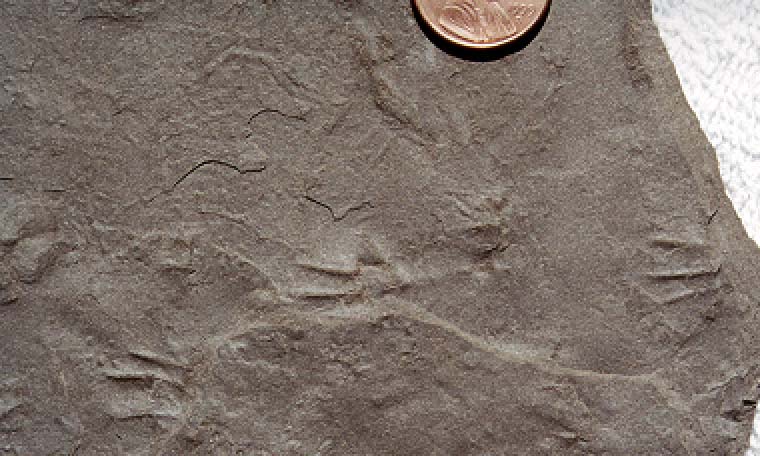 |
| | Fig. 9 - A small set of tracks with three clear toes, probably of the
genus Cincosaurus. |
| |
| Fig. 10 - Small tracks of unknown creature,
from part of a much larger slab with 3 or 4 criss-crossing tracks. Each
track is less than a penny in size. |
| |
| |
| Fig. 11 - This piece shows two different
sets of tracks, one larger set going left, and a smaller set going
right. The two sets overlap, giving a confusing pattern of overlapping
prints. |
| |
| |
| Fig. 12 - This piece includes tracks of probably one of the same two creatures in Figure 11. |
| |










